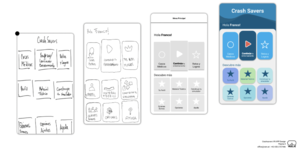
The physical simulator is essential to the psychomotor educational component of the training course, though successful application of appropriate hemorrhage control techniques still requires a thorough understanding of indications and patient presentations in different clinical circumstances. Accordingly, our VR app has been designed in the setting of a gamified learning environment to enhance engagement and retention and to complement the physical model. The CrashSavers VR app includes the following components:
- Step-by-step instructions on constructing the DIY Simulator
- Educational material on anatomy and decision-making for different hemorrhage control techniques
- Virtual simulator to master skills and steps for hemorrhage control techniques
- Self-assessment
The educational material includes content on anatomy, decision-making, and video instruction on how to appropriately perform the hemorrhage control techniques for both the simulator and real-life scenarios. The virtual simulator component within the VR app will allow learners to practice the steps of the different hemorrhage control techniques in order to become competent. Upon completion of the educational modules, learners will advance to performing their learned skills on the physical simulator model.
Targeted Learners[edit | edit source]
Like many low- and middle-income countries, Guatemala lacks an orgranized EMS system as well as a well-established infrastructure for prehospital care. All prehospital care is provided by 3 independent firefighting organizations that are largely comprised of volunteer services. Transport vehicles and other medical equipment are rarely available, and oftentimes, firefighters buy the necessary equipment themselves.
In addition to the inadequacy of a formalized prehospital infrastructure, medical training and education are lacking for prehospital providers. Anyone with a 6th grade education is eligible to become a firefighter in Guatemala and must subsequently complete a 2-week, 160-hour course endorsed by USAID. One of the firefighter training programs offers an optional 2.5-year EMT course, though very few actually complete this. Due to the training deficiency and volunteer status of most of the firefighters providing prehospital care, the majority of prehospital care consists of an erratic “scoop and run” approach rather than a systematic process to obtain vitals, perform adjunctive procedures, and provide significant stabilization of the patient prior to transport to definitive care.
Ultimately, the 8,500 firefighters who have basic first aid training, have little to no equipment available, and work in a poorly organized system are responsible for tending to the emergency needs of 18 million Guatemalans. These providers can greatly benefit from formalized training in hemorrhage control techniques.
Skills Acquisition[edit | edit source]
Effective hemorrhage control in injured patients requires prompt, decisive action and forceful application of pressure. Through our CrashSavers Trauma course, learners will gain skills in external compression of a wound, tourniquet application, and foley catheter compression to stop the bleed in a physical simulator model of a bleeding lower extremity. The simulator model is made from low-cost materials available at hardware stores (ex. PVC pipe, wire mesh, metal racking, springs, tubing, plumber’s tape) and integrated with an electrical, fluid pumping system.
Learners will have 2 sources of feedback: 1) direct visualization of stopping the hemorrhage, and 2) a readout of the pressure and displayed in the VR app based on pressure applied by the learner and measured by model sensors.